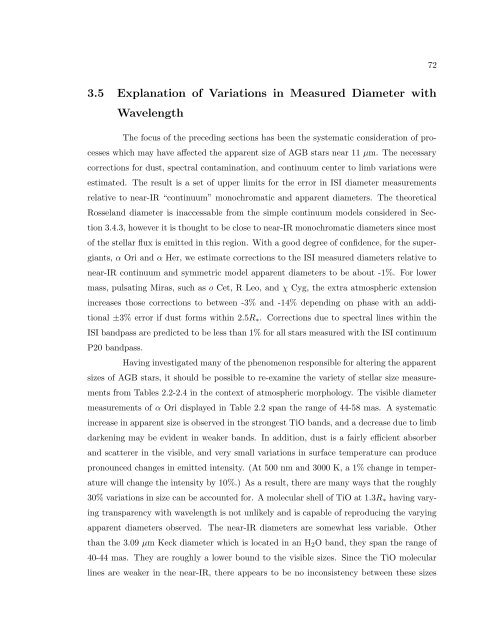The Size, Structure, and Variability of Late-Type Stars Measured ...
The Size, Structure, and Variability of Late-Type Stars Measured ...
The Size, Structure, and Variability of Late-Type Stars Measured ...
Create successful ePaper yourself
Turn your PDF publications into a flip-book with our unique Google optimized e-Paper software.
72<br />
3.5 Explanation <strong>of</strong> Variations in <strong>Measured</strong> Diameter with<br />
Wavelength<br />
<strong>The</strong> focus <strong>of</strong> the preceding sections has been the systematic consideration <strong>of</strong> processes<br />
which may have affected the apparent size <strong>of</strong> AGB stars near 11 µm. <strong>The</strong> necessary<br />
corrections for dust, spectral contamination, <strong>and</strong> continuum center to limb variations were<br />
estimated. <strong>The</strong> result is a set <strong>of</strong> upper limits for the error in ISI diameter measurements<br />
relative to near-IR “continuum” monochromatic <strong>and</strong> apparent diameters. <strong>The</strong> theoretical<br />
Rossel<strong>and</strong> diameter is inaccessable from the simple continuum models considered in Section<br />
3.4.3, however it is thought to be close to near-IR monochromatic diameters since most<br />
<strong>of</strong> the stellar flux is emitted in this region. With a good degree <strong>of</strong> confidence, for the supergiants,<br />
α Ori <strong>and</strong> α Her, we estimate corrections to the ISI measured diameters relative to<br />
near-IR continuum <strong>and</strong> symmetric model apparent diameters to be about -1%. For lower<br />
mass, pulsating Miras, such as o Cet, R Leo, <strong>and</strong> χ Cyg, the extra atmospheric extension<br />
increases those corrections to between -3% <strong>and</strong> -14% depending on phase with an additional<br />
±3% error if dust forms within 2.5R ∗ . Corrections due to spectral lines within the<br />
ISI b<strong>and</strong>pass are predicted to be less than 1% for all stars measured with the ISI continuum<br />
P20 b<strong>and</strong>pass.<br />
Having investigated many <strong>of</strong> the phenomenon responsible for altering the apparent<br />
sizes <strong>of</strong> AGB stars, it should be possible to re-examine the variety <strong>of</strong> stellar size measurements<br />
from Tables 2.2-2.4 in the context <strong>of</strong> atmospheric morphology. <strong>The</strong> visible diameter<br />
measurements <strong>of</strong> α Ori displayed in Table 2.2 span the range <strong>of</strong> 44-58 mas. A systematic<br />
increase in apparent size is observed in the strongest TiO b<strong>and</strong>s, <strong>and</strong> a decrease due to limb<br />
darkening may be evident in weaker b<strong>and</strong>s. In addition, dust is a fairly efficient absorber<br />
<strong>and</strong> scatterer in the visible, <strong>and</strong> very small variations in surface temperature can produce<br />
pronounced changes in emitted intensity. (At 500 nm <strong>and</strong> 3000 K, a 1% change in temperature<br />
will change the intensity by 10%.) As a result, there are many ways that the roughly<br />
30% variations in size can be accounted for. A molecular shell <strong>of</strong> TiO at 1.3R ∗ having varying<br />
transparency with wavelength is not unlikely <strong>and</strong> is capable <strong>of</strong> reproducing the varying<br />
apparent diameters observed. <strong>The</strong> near-IR diameters are somewhat less variable. Other<br />
than the 3.09 µm Keck diameter which is located in an H 2 O b<strong>and</strong>, they span the range <strong>of</strong><br />
40-44 mas. <strong>The</strong>y are roughly a lower bound to the visible sizes. Since the TiO molecular<br />
lines are weaker in the near-IR, there appears to be no inconsistency between these sizes













![Problem #1 [Structure Formation I: Radiation Era]](https://img.yumpu.com/37147371/1/190x245/problem-1-structure-formation-i-radiation-era.jpg?quality=85)


